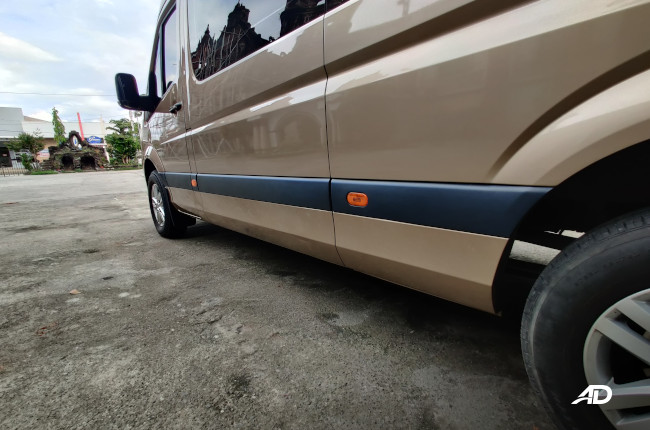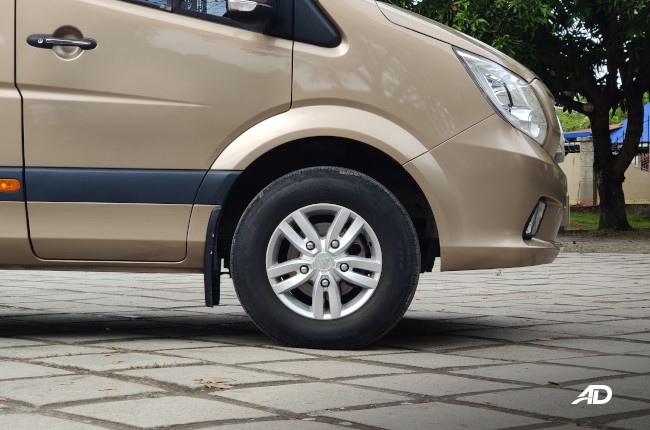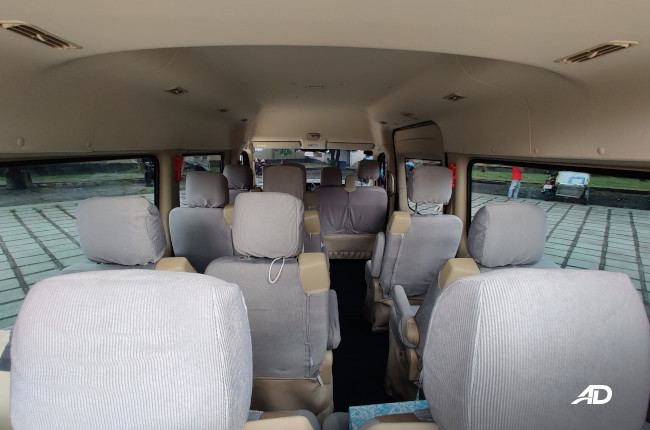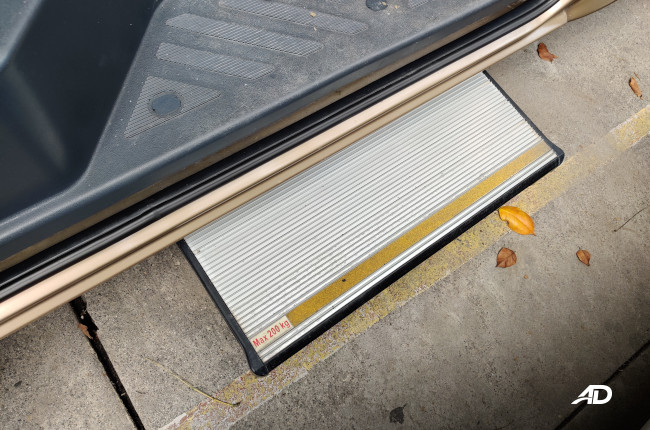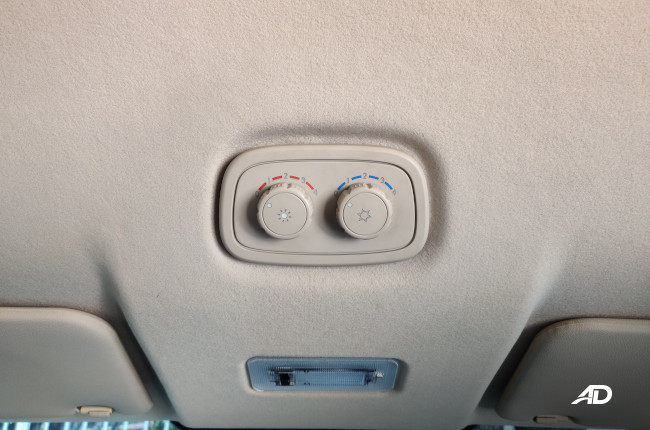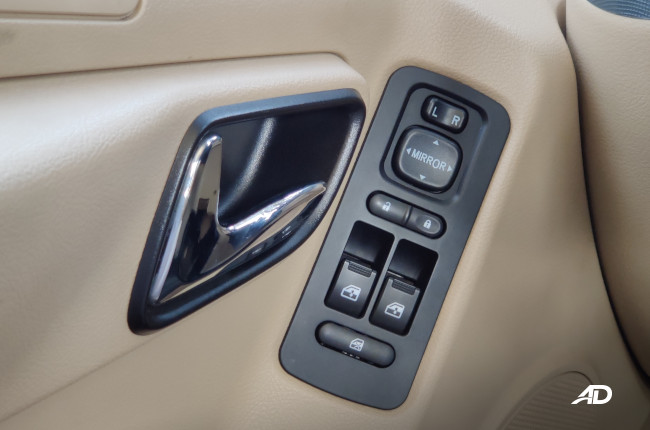
Contents
It is highly unlikely that a high-occupancy vehicle will be loaded up to maximum capacity all the time unless we’re talking about a transportation service. The extra space and seats will be under-utilized, and an “it’s there when you need it” feature for most consumers; that’s not even going into the realm of price yet. The point here is, that no individual needs a car that big, but perhaps a large family will, or even a small business in need of a shuttle service.
The Foton Toano is in a certain middle ground for consumers and small businesses. The model has a relatively accessible price point considering the size and the space that this particular minibus offers. For your average consumer, it allows them to consider a van of this size knowing that they might not use it all the time. As a service vehicle, however, it’s an option since money is definitely an object. In its Standard 2.8L MT 15-seater variant, the mini-bus costs P1,978,000, a relative bargain in its segment considering that other models will be more expensive. The price-point does indicate that it is an entry-level offering in the market, but just how good is it?
Engine Output (HP), Acceleration, Transmission, Handling 4.0/5
Exterior & Interior Design, Quality, Fit and Finish, Ergonomics 3.5/5
Cabin Comfort, Suspension, NVH Insulation 3.0/5
Convenience Technologies, Active and Passive Safety Features 3.0/5
Amount of the vehicle you get for the price, Fuel Efficiency 4.0/5
- Good performance from the Cummins engine
- Passenger step board is useful
- Accessible price point
- Anemic safety features
- NVH is intrusive
- Ride quality is so-so
Exterior
Boxy is an understatement. Foton did incorporate some curves and lines around the vehicle to add some aerodynamics and style, but ultimately, it’s not going to win awards because it was never meant to be a beauty queen. The looks are completely fine, and mediocre, which is expected from this segment. The headlamps are swept up, and the grille is wide with two silver slats surrounding the Foton logo.
There is no getting around the sheer size of this vehicle. It’s long, tall, and requires some orange auxiliary lights as an added visibility factor for other vehicles at night. Since the vehicle is geared more towards utility, I forgave things like the bumper not having a clear-coat, or the uninspiring 16-inch wheels. It won’t get you with the looks, it’ll get you with its size.

The roof is high and might inhibit you from entering underground parking lots coming in at 2,415 mm. The vehicle is only 5mm shy of 6,000 mm with regard to its length, and it definitely shows. Its presence is imposing and gargantuan and dwarfs almost anything I put next to it. Oh, and good luck finding a parking slot that will fit this giant – scratch that, good luck finding a parking lot that can fit this since it is wide at 2,430 mm.
Interior
The interior is nothing special. Considering that this is one of the more affordable models in its segment makes its rather hollow interior, again, forgivable. All of the important bits that are used to control the car were rock-solid, however. For the passengers, the seats felt soft and reasonably supportive, as were the grab handles. The most uncomfortable seat in the car is probably the middle seat in the front, next to the driver. Legroom is a bit lacking in that seat, but it’s probably the last chair to be occupied anyway.
There are no cup holders for the passenger area. Only the driver and front passengers are given the luxury of a bottle holder or cupholder. While interior storage is lacking, the space inside is immense. As a reference, my mother who stands at 5-feet tall on a good day can stand inside the passenger area without any problems. The split rear doors open up and reveal a cargo area that is tall but not that deep. If you’ll haul items in the Toano, the cabin area is free game.
Ingress and egress is also a breeze even with its high stance because of a motorized step board that reveals itself every time the big sliding door is opened; and like most commuter vans, the door is set to one side, allowing for a lane for passengers to walk through. Unlike most commuter vans, there are five rows of seats but up to 15 occupants can be seated at once. Full-size vans can seat as many as the Toano, but space is on the tighter side. The Toano seats 15 rather comfortably, without much compromise in legroom.
Comfort

There is a gradient of comfort in the Toano, meaning that the further back you go, the bouncier it gets. This is because of the leaf spring suspension in the rear. Comfort in the front is pretty good because of the independent suspension setup, but going over a divot in the road is a bittersweet experience since the front wheels will take it without issue, while the rear will overreact and introduce vibration into the cabin. NVH is also on the average side, but considering the size of the car, it’s understandable why. The engine does shake up the cabin a bit, but those motions dissipate the further you situate yourself from the bay.
The driver doesn’t have as much space I had hoped, but the seat is height and tilt adjustable, which makes it easier to find a comfortable driving position. The passengers at the back can recline their seats, but the positions can’t be changed so where you sit is what you get. There are also air vents for the rear passengers, which can double as a heater if need be.
Technology

Foton specializes in commercial vehicles. Their research and development team might not even see the need to invest heavily in an infotainment system that will revolutionize the industry. That being said, you do get basic – and I do mean basic functionality out of the 2-DIN AM/FM tuner with AUX connectivity. It makes sense that there’s no advanced audio system because the driver is not the focus of this vehicle anyway, but Bluetooth would have been a logical addition so rear passengers can at least listen to music without distracting the driver who will – quite literally – have his hands full with the vehicle. Since there is no screen, there is no backup camera. I wish Foton included one here since the rearview mirror is essentially useless because of the split opening cargo doors. You do get a set of parking sensors front and back, however, so that’s a saving grace.
There isn’t much else to be found in the cabin, the trip computer shows your range and fuel economy that’s read in L/100km. Some menu elements here are in Chinese though, so unless you are well-versed in the language, then you can probably infer the numbers anyway.
Safety

The Toano has three-point seatbelts for all 15 of its occupants. Accompanying this is the airbag for the driver, and that’s about it. Of course, a rig this large will need ABS and electronic brakeforce distribution, which it has. Otherwise, safety is sorely lacking, though, it’s somewhat acceptable given the price point. I would have liked to see more.

A bit of an oddity for safety is a pair of hammers. These little red devices are put in place to break the glass of the Toano should the need arise and the passengers find themselves trapped in the cabin.
Driving and Handling

The motor powering the Toano is a 2.8L Cummins diesel engine that produces 161 hp and 360 Nm of torque. The engine paired with the chassis returns acceptable acceleration. It’s par for the course as far as minibusses go. Clutch actuation is a little springy and on-off. There is a noticeable point in the pedal travel where the clutch is being activated. There is also no footrest, so this type of feedback is good for the driver.

The steering wheel does feel solid to use, but the gear lever is a little vague at times, and has a long throw. Visibility all throughout the cabin is superb for all occupants especially the driver. This is helped by a set of 4 mirrors, 2 on each side. A low angle, non-adjustable mirror is present as is a large electronically adjusting unit for both sides. Reversing is an issue because there is no backup camera, only parking sensors in the front and the back.

It’s obvious that this mammoth is a handful to drive made manageable through good front visibility. The seating position alone is enough to make you feel like a bus or truck driver. This feeling is cemented by the fact that the base Foton used for this vehicle is from its commercial vehicles, a ladder frame rear-wheel-drive platform. That being said, it handles like a truck. A high seating position with a high center of gravity, with a lot of body roll in corners. The wheels are quite thin for the Toano, and it seems to be rolling on stilts, which should indicate how fast you should go on challenging twisty roads – very slow.
Fuel Economy

Being a diesel vehicle has many perks. The added torque allowed the vehicle to pull more weight. This is the case in the Toano, as it returned a fuel economy figure of 6-7 km/L in the city, and 12-13 km/L on the highway. In heavy traffic, expect the number to dip down to 5-6km/L, whereas in light traffic, expect that number to climb to 8 km/L. I mentioned that the figure is good because full-size SUVs typically throw down similar or worse figures than the Toano. Where they have it beat was in the 90 km/h test on the highway because of a few factors like aerodynamics and the low-revving nature of diesel engines.
Of note, I did have over 10 people in the car while doing my highway test, and going at 80 kp/h, since 90 km/h taxes the engine quite a bit. City drives were conducted with only two occupants inside.
Verdict

This isn’t a consumer’s everyday vehicle, but it could be a business’ workhorse. It’s a tour bus more-or-less. I spent an entire day with this car to go with my mother’s friends on a food trip to Pampanga. We were more than 10 in the car, and the wide windows made for a perfect tourist carriage. Driving was also not as bad as I anticipated. The turning radius was pretty good for its size, and it was just a minor adjustment for me. The seating position is something to get used to, though.
Overall, it’s not a car that I would buy for personal use. If I was running a resort or a shuttle service, however, it seems like a utilitarian choice. No frills or flair; it gets the job done. It’s maximum space for a minimum price, and as I said earlier, no individual needs all this space, but it’s there when you need it, and the Toano has that aspect in truckloads. At a price of P1,978,000, which is just a hair under P2,000,000, the Toano is a more affordable entry into the market, especially since this class of vehicle usually hits near the P3,000,000 mark. It’s a bargain for what it is and as a workhorse in a fleet, it should accomplish its task while not burning a hole through your wallet.
Exterior Photo Gallery
Interior Photo Gallery
Specifications
Engine
2.8 LFuel Type
DieselPerformance
161 hp @ 3,600 rpmTransmission
Manual-
Summary
-
Name Foton Toano 15-seater Body Type Van Price ₱2,160,000 Transmission Category Manual -
Engine
-
Engine Size 2.8 L Displacement 2,800 cc Number of Cylinders 4 Number of Valves 16 Transmission Type 6-speed Manual -
Performance
-
Drivetrain Rear Wheel Drive Max Output (hp) 161 hp @ 3,600 rpm Max Torque (nm) 380 Nm @ 1,800 rpm -
Economy & Environment
-
Fuel Type Diesel Emissions Standard Euro 4 Fuel Capacity 80.0 L *Combined Fuel Consumption 11.5 km/L *brand manufacturer claim
-
Dimensions
-
Length 5,995 mm Width 2,000 mm Height 2,415 mm Wheelbase 3,750 mm Turning Circle 14 m Ground Clearance 160 mm Trunk Capacity n/a Number of Doors 4 Number of Seats 15 -
Safety & Security
-
Driver's Airbag 1 Front Passenger's Airbag Side Airbag Curtain Airbag Knee Airbag Auto Brake System Electronic Brake Distribution Anti-lock Brake System (ABS) With Electronic Brake-force Distribution (EBD)
Immobilizer Security Alarm Stability Control Electronic Door Locks Speed Sensing Door Locks ISOFIX Lane Departure Warning System Blind-Spot Detection System -
Features
-
Cruise Control Front Parking Sensors Rear Parking Sensors Leather Upholstery Push Start Button Wheel Size 16 in Wheels Metal Type Steel Airconditioning System Dual Air Conditioning System Entertainment System Single-DIN AM/FM Radio Connectivity AUX. CD Player and USB Navigation Ready Warranty 5 Years (150,000 km) Keyless Entry Roof Rack Sunroof Electric Adjustable Seats Power Steering Power Windows Power Outlet Steering Wheel Audio Control -
Technology
-
Active Park Assist Hill Start Assist AWD Modes n/a Tire Pressure Monitoring Heads-up Display Power Liftgate Start-stop System
Latest Review
-
Addictively excessive: The Ford Ranger Raptor Twin Turbo V6 / Review
The Ford Ranger Raptor Twin Turbo V6 is one crazy pickup truck. Wondering why? Just keep reading.
4.6 / 5 -
The Kia Carnival gives you more: More seats, more comfort, and more practicality / Review
The Kia Carnival is a three-row MPV designed for executives and families. It combines comfort, technology, and practicality, making it a strong choice for those looking for a premium people...
4.2 / 5 -
The Jetour Ice Cream: A pint-sized EV that’s hard to ignore / Review
The Jetour Ice Cream is an adorable, pint-sized electric car that’s made for the city. Affordable and stylish, it’s easy to love, but does it tick all the boxes for you?
3.7 / 5
Popular Articles
-
Cheapest cars under P700,000 in the Philippines
Jerome Tresvalles · Sep 02, 2024
-
First car or next car, the Ford EcoSport is a tough package to beat
Jun 18, 2021
-
Car Maintenance checklist and guide – here’s everything you need to know
Earl Lee · Jan 12, 2021
-
Most fuel efficient family cars in the Philippines
Bryan Aaron Rivera · Nov 27, 2020
-
2021 Geely Okavango — Everything you need to know
Joey Deriquito · Nov 19, 2020
-
Family cars in the Philippines with the biggest trunks
Sep 20, 2023
-
Head to head: Toyota Rush vs. Suzuki XL7
Joey Deriquito · Oct 28, 2020
-
Why oil changes are important for your car
Earl Lee · Nov 10, 2020
-
2021 Kia Stonic — What you need to know about it
Joey Deriquito · Oct 16, 2020
-
Top 7 tips for buying a used car in the Philippines
Joey Deriquito · Nov 26, 2020





